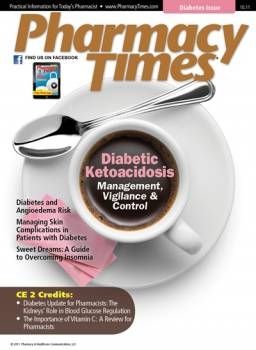Drug Interactions with Simvastatin: The Risk Continues
Recent FDA actions regarding simvastatin mean that pharmacists should refresh their knowledge of this cholesterol-lowering medication.
Recent FDA actions regarding simvastatin mean that pharmacists should refresh their knowledge of this cholesterol-lowering medication.
In June 2011, the FDA placed new labeling restrictions on simvastatin. The changes recommended against using 80-mg doses of simvastatin, added 4 drugs to the list of contraindicated agents, and included several new simvastatin dose limitations when prescribed with drugs that inhibit its elimination.1 In June 2006, this column warned of the risk of taking simvastatin in combination with drugs known to interfere with its elimination (cytochrome P450 [CYP] 3A4 and organic anion transporting polypeptide 1b1 [OATP1b1]), especially with the 80-mg dose.2
Why the Label Revision at This Time?
The FDA based its label revision on analysis of a study comparing simvastatin 20 mg with 80 mg daily in patients with a history of myocardial infarction.3 The incidence of myopathy was 30 times higher (0.03% vs 0.9%) in patients taking simvastatin 80 mg compared with 20 mg. Seven cases of rhabdomyolysis occurred, all in patients taking 80-mg doses. Another 7 patients had creatine kinase levels greater than 40 times normal but were not diagnosed with rhabdomyolysis due to a lack of data on end organ damage.
About midway through the trial, simvastatin was limited to 20 mg in patients taking amiodarone because amiodarone was noted to be associated with increased risk of myopathy. No data have been published on the use of other drugs known to alter simvastatin elimination by the study participants. These data supported the idea that 80-mg doses of simvastatin were too risky to use in light of its limited therapeutic advantage over the 20-mg dose (incidence of major coronary events 25.7% vs 24.5% for 20 and 80 mg, respectively).
Does Simvastatin Have a Unique Risk for Drug Interactions?
Although all statins may be affected by drug interactions, simvastatin is exceptionally sensitive for several reasons. One of the unique properties of simvastatin is very low bioavailability (<5%) due to high firstpass metabolism. For example, if a 20-mg dose is administered, only 1 mg reaches the systemic circulation. Increasing the bioavailability to 50% with a CYP3A4 inhibitor will increase the systemic exposure by 10-fold, to 10 mg.
In contrast, atorvastatin has a bioavailability of 15%. Increasing atorvastatin’s bioavailability to 50% would increase its systemic exposure by 3.3-fold, from 3 to 10 mg. Grapefruit juice, which only affects first-pass metabolism, increases the area under the concentration time curve (AUC) of simvastatin by about 1500%, but only increases atorvastatin AUC by 150%. Increases due to first-pass metabolism will occur in addition to any changes in systemic clearance. Thus, simvastatin is much more susceptible to interactions based on CYP3A4 inhibition than atorvastatin, despite both drugs being primarily metabolized by CYP3A4.
Secondly, all statins are transported from the blood into the liver by OATP1b1. This transport facilitates the hepatic metabolism of the statin. Reduced OATP1b1 activity due to genetic variation has been associated with increased simvastatin plasma concentrations (3- to 4-fold) and incidence of myopathy.4 About 15% to 20% of the population carries a genetic mutation that reduces the activity of OATP1b1. A number of drugs are known to inhibit OATP1b1 (eg, clarithromycin, erythromycin, cyclosporine, ketoconazole, many protease inhibitors, gemfibrozil) and are known to increase simvastatin concentrations.5 Note that many OATP1b1 inhibitors are also CYP3A4 inhibitors, which provides the opportunity for a dual mechanism drug interaction with simvastatin.
Should Simvastatin Be Avoided in All Patients?
No, the risk of myopathy or rhabdomyolysis is still low. The inclusion of generic simvastatin as the preferred formulary statin combined with the lowering of lowdensity lipoprotein goals has increased patient exposure to higher doses of simvastatin. This will increase the number of patients exposed to high concentrations of simvastatin due to genetic factors or the administration of interacting drugs. The label has been modified to include more CYP3A4 inhibitors; however, several CYP3A4 inhibitors are not listed (eg, fluconazole, voriconazole, conivaptan, dronedarone, imatinib). Higher doses (>20 mg) of simvastatin should probably be avoided in patients known to be deficient in OATP1b1 or who are receiving an OATP1b1 inhibitor or CYP3A4 inhibitor.
Summary
A combination of events resulting in more patients being exposed to higher doses of simvastatin has increased the risk for drug interactions and side effects. All statins can produce muscle toxicity and are susceptible to some drug interactions. It would appear that the increased risk associated with simvastatin is not balanced by an increase in benefit (even if monetary) in patients requiring higher doses or those taking potentially interacting drugs. PT
Drs. Horn and Hansten are both professors of pharmacy at the University of Washington School of Pharmacy.
References
1. FDA drug safety communication: New restrictions, contraindications, and dose limitations for zocor (simvastatin) to reduce the risk of muscle injury. Safety Announcement, June 8, 2011. www.fda.gov/drugs/drugsafety/ucm256581.htm.
2. Horn JR, Hansten PD. Be on the alert for increasing drug interactions with statins. Pharmacy Times. 2006;72(6):20.
3. Study of the Effectiveness of Additional Reductions in Cholesterol and Homocysteine (SEARCH) Collaborative Group; Armitage J, Bowman L, Wallendszus K, et al. Intensive lowering of LDL cholesterol with 80 mg versus 20 mg simvastatin daily in 12064 survivors of myocardial infarction: a double-blind randomized trial. Lancet. 2010;376:1658-1669.
4. The SEARCH collaborative group. SLCO1B1 variants and statin-induced myopathy — a genomewide study. New Engl J Med.2008;359:789-799.
5. Niemi M et al. Organic anion transporting polypeptide 1b1: a genetically polymorphic transporter of major importance for hepatic drug uptake. Pharmacol Rev. 2011;63:157-181.

